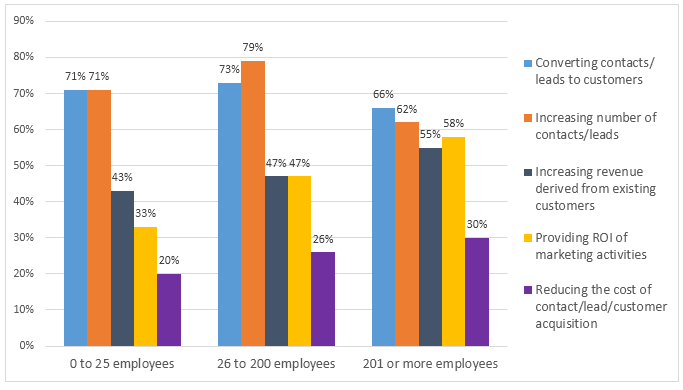IELTS graph 243 - Top priorities by business companies in the USA
- Details
- Last Updated: Thursday, 18 October 2018 18:59
- Written by IELTS Mentor
- Hits: 58762
IELTS Academic Writing Task 1/ Graph Writing - Column/ Bar Graph:
» You should spend about 20 minutes on this task.
The graph below shows the top priorities by business companies in the USA in 2016.
Summarise the information by selecting and reporting the main features and make comparisons where relevant.
Write at least 150 words.
Top Priorities by Company Size

Sample Answer 1:
The bar graph outlines the comparative analysis of the American company's top five priorities in 2016 according to the size of the company. The striking feature to note is that irrespective of the size of the companies, primary importance was given to raising the number of contacts and converting them to customers.
Looking deep at the details, every company's two top priorities were to keep on increasing leads and to turn those leads into customers. Small businesses, with 0-25 employees, gave equal emphasis to these two aspects. But a company with 26-200 employees gave the lead generation and customer conversion the highest priority.
Since small and medium companies spent more on lead generation, they focused less on cost minimisation to gain customers. Contrary to this, 30% priority was set by large organisations (more than 201 employees) to reduce this cost and they set the target to earn profit from existing customers. Medium-sized industry indicated 47% to both increasing revenues derived from existing customers and providing ROI of marketing activities, whereas, 55% and 58% precedence from a large company and 43% and 33% from the small company was assigned respectively to the same objectives.
[Written by - Divya]
Model Answer 2:
The bar graph shows the priorities set by businesses in the United States in 2016 based on their sizes. As is obvious, small and medium businesses put more emphasis on increasing leads and gaining customers while large companies fairly distributed their priorities on lead generation, customer acquisition, increasing income and providing ROI to marketing.
In details, small US business companies with less than 25 employees put equal emphasis on converting contacts to leads and increasing leads. They put 71% priority on both of these aspects as they were more focused on generating leads and turning them into customers. 33% of their priority was set to providing Return on Investment (ROI) to marketing actions and 20% on deducting expenses on obtaining new clients.
Medium companies, having employees 26 - 200, put the highest emphasise (79%) on increasing leads. Their second priority was converting contacts to customers, 73% priority. Their priority for earning more from existing customer and marketing ROI were equal, 47%. Finally, companies having more than 200 employees, large businesses, put almost a similar importance on all these aspects except reducing lead generation cost which was the least priority by all these companies.

Overall, increasing the number of contacts and converting them into leads was the main priority, whilst reducing costs was the least important. Besides, it shows that with increasing company size, other tasks were prioritised.
Increasing the number of leads as well as turning them to customers were the main priorities for all companies. Smaller companies (0 to 25 employees) found the tasks equally important at 71%. Whilst middle-sized companies (20 to 200 employees) slightly prioritised the increasing number of contacts at 79% over converting to customers at 73%. Whilst large companies (201+ employees) gave slightly more important to converting existing contacts to customers than increasing their number.
The lowest prioritised task was reducing the costs of attaining contacts, leads and customers for all companies. However, the bigger the company, the more this was prioritised, increasing from 20% to 30% in small and large companies, respectively. Additionally, other tasks that increased with company size included: increasing revenue from existing customers and providing ROI of marketing activities. The latter having the most dramatic increase in priority from 33% to 58%, from smaller to larger companies respectively.
Report